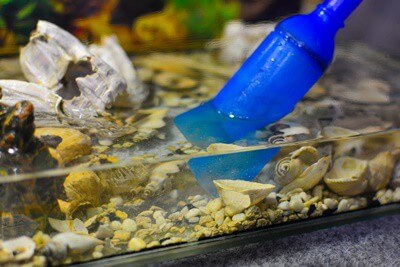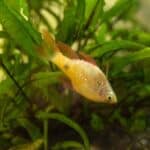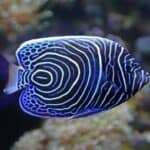The right water temperature is one of the most critical things in a fish tank. All fish have precise requirements, and even the slightest temperature change can wreak havoc on the environment and make them sick. Sudden water changes could even kill them.
Cold water can kill warm-water fish, especially if the tank experiences a sudden drop in temperature. That’s because cold water slows the fish’s metabolism, weakens their immune systems, and leaves them more susceptible to parasite outbreaks, including ick. Cold temperatures cause fish to develop cold shock, which is a form of stress that’s usually fatal.
To protect your fish, you’ll need to raise the water’s temperature in a controlled, gradual manner. Prolonged exposure to cold water leaves fish vulnerable to too many conditions.
How Does Cold Water Affect Fish?
Fish are cold-blooded, which means they can’t regulate their body temperature. Instead, they get their body temperature from the water. That’s why you must keep your aquarium’s water at the right temperature to prevent your fish from becoming unwell or dying.
Tropical fish prefer temperatures that range between 75° and 80°F. “Cold-water” species, such as goldfish, prefer temperatures ranging between 68° and 74°F. That being said, even cold-water fish are affected by a sudden drop in temperature.
Cold water isn’t a particularly good thing for fish and can affect them in the following ways:
Slower Metabolism
When the tank’s water’s too cold, your fish’s metabolisms slow down, preventing them from consuming oxygen as quickly as they need to.
As described by Symposia of the Society for Experimental Biology, metabolic activity reduces because cold water causes changes to the physical chemistry of cell production.
While fish may swim more in cold waters, their active metabolic rate remains considerably lower than it should. Low metabolism prevents fish from being able to find food or escape from predators, causing them to become slow and sluggish.
In some cases, fish are unable to digest their food properly because of their slow metabolism. You’ll know if this happens because the food will come out looking the same as it went in.
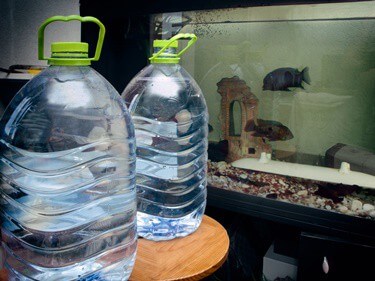
Weak Immune System
When the aquarium water’s too cold, the immune system can’t function properly. This causes the following problems:
- Antibiotics don’t work in the way they should, as they need assistance from the immune system.
- Fish can’t heal properly after surgery.
- Fish can’t protect themselves against infections and disease.
Prolonged exposure to cold water causes a fish’s immune system to weaken, making it susceptible to bacteria and parasites. Similarly, a fish’s immune system isn’t very advanced, so even the smallest changes to its environment can compromise it.
When the immune system begins to function inefficiently, infected fish will display symptoms of a fever. They’ll also try to look for warmer areas and may remain close to the water’s surface as a result.
Both of these are clear signs that you need to address the temperature in your fish tank.
Parasite Outbreaks
Colder temperatures are linked to parasite outbreaks. As described by Ecology and Evolution, fish parasites respond directly to the environment and react to water quality and temperature.
For example, fish are more susceptible to ich, or white spot disease as it’s also known, when the water’s temperatures suddenly change. As described by the University of Florida, that’s primarily because cold water prolongs the life cycle of ich. Signs of ich include:
- Characteristic white spots around the fins and gills
- Difficulty breathing
- Gasping at the water’s surface
- Rubbing against objects to relieve the itching
When combined with a low immune system because of cold water, fish are at greater risk of catching something that could kill them.
Longer Aquarium Cycle
Lower water temperatures cause the tank’s beneficial bacteria to become less active. This means the tank will take longer to cycle. The whole point of a cycle is to encourage beneficial bacteria to grow and eat harmful ammonia and nitrites as soon as these chemicals are produced.
If ammonia and nitrites are allowed to rise too quickly because the bacteria can’t remove them fast enough, the aquarium is at risk of harmful chemical spikes. Fish are highly susceptible to ammonia poisoning and usually die soon after developing symptoms.
Stress
As explained by Fish Biology, when water temperatures suddenly drop, fish develop cold shock. This is a form of cold-induced stress that triggers a range of physiological and behavioral responses. Symptoms of cold shock include:
- Lethargy
- Changes to swimming behavior
- Lying dormant at the bottom of the tank
- Loss of appetite
Stress is one of the most fatal conditions for fish. To save your fish, you’ll need to safely raise the water’s temperature and encourage them to eat by hand-feeding them until they regain their appetite.
What To Do If Fish Water Is Too Cold?
If your fish’s water is too cold, you’ll need to warm it up so that it’s within a suitable temperature parameter for your fish.
Thankfully, there are many easy steps you can take to do this. Just be careful not to raise the temperature too high, as water that’s too hot is as harmful as water that’s too cold.
Follow these steps to increase your tank water’s temperature:
Aquarium Heater
The quickest way to warm up cold water is with an aquarium heater. Heaters are essential for tropical aquariums as they keep the water at a safe level. They also regulate the water at the temperature you set it at, preventing it from dropping and becoming too cold.
Most heaters are also reasonably priced and won’t break the bank. There are two types available. The first submerge entirely into the water, while traditional-style heaters have a partially submerged glass tube that leaves the controls above the water.
Submersible heaters are the better option, as they can be placed horizontally along the tank’s floor, allowing the heat to rise simultaneously. It also prevents it from becoming exposed each time you do a water change, like traditional heaters.
Increase The Room’s Temperature
An easy yet slightly slower way to increase the water temperature is to raise the temperature of the room in which your tank lives. This is more crucial in colder months than warmer. Aim to keep the room at around 21 to 22 degrees Celsius to keep conditions regulated.
When it gets warmer, you’ll need to lower the room temperature in line with outdoor conditions. Otherwise, the tank could overheat.
Ensure you have an aquarium thermometer to hand so that you can regularly check the water’s temperature and adjust it accordingly.
Heat A Plastic Bottle
If you need to raise the water’s temperature quickly but don’t have a heater, a quick-fix is to place boiling water that’s cooled slightly inside a secure plastic water bottle before putting it into the water. This will instantly warm the tank.
You might need to do this a few times before the water’s at the right temperature. Similarly, you should monitor the water temperature at all times to prevent the tank from overheating.
Another thing to bear in mind is that this is only a short-term solution. Eventually, the water will get cold again unless you raise the room’s temperature or invest in a heater to regulate the temperature.
Use A Lid
Some tanks don’t have lids, which is the most likely reason why the water gets too cold. Covers trap heat and prevent the warmth from evaporating into the air. Not only that, but lids stop fish from leaping out of the tank and suffocating to death.
If you don’t currently have a lid, it might be time to find a good-quality glass cover to help regulate the water’s temperature.
Wrap The Tank In A Blanket
For a short-term fix while you source a lid, wrap the tank in a warm blanket or towel to lock in as much of the heat as you can. This method is unlikely to cause the tank to overheat, but you’ll need to do it at night when it’s dark so that you don’t mess up your fish’s sleep cycle.
Position The Tank Properly
Depending on how much space you have inside your home, move the tank to a warm area of your house, away from windows and draughts. This could be one of the main reasons why your tank is getting so cold in the first place.
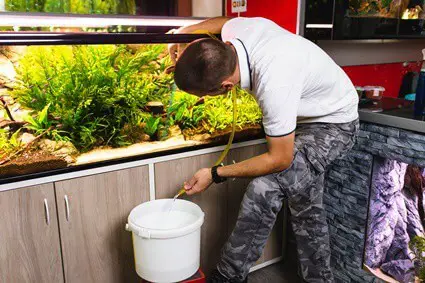
Can I Add Warm Water To A Fish Tank?
Adding warm water that has a significantly different temperature to what’s in your tank could be harmful to your fish. That’s because, as we’ve already mentioned, sudden water changes can induce fatal stress.
However, you can use warm water to gradually and slowly increase the overall temperature, mixing it with a bit of cold water to ensure it’s not too hot.
Treat this method as a water change and aim only to change around 5-10% of the tank’s water at one time. If you add it on top of the water you already have, you’re at risk of throwing the ecosystem out of balance. Similarly, changing too much water at one time leads to shock and can kill your fish.
If you’re using tap water, you’ll need to treat it first to remove chlorine and chloramine. You can do this using chemicals or a conditioner, or you can leave it to sit for 24 hours while the chlorine evaporates into the air. If you put warm tap water directly into your tank, you’ll likely kill the fish.
This method isn’t the most fool-proof. Choosing a reliable aquarium heater is the best way to increase your tank’s water temperature.
Which Fish Survive In Cold Water?
There are several fish that can survive in cold waters – though they still need specific temperature parameters. The most common and popular cold-water fish is the goldfish, which can tolerate freezing temperatures for a short while. However, its ideal temperature ranges between 68° and 74°F.
There are also plenty of other fish that can tolerate temperatures around the mid-60s (Fahrenheit), including:
- Rosy barb
- Bloodfin tetra
- Buenos Aires tetra
- Pearl danio
- Zebra danio
Interestingly, there is one known warm-blooded fish. The opah fish, or moonfish as it’s also known, is the first fully warm-blooded fish, allowing it to live in cold ocean depths between 150 to 1,300 feet below the surface.
It keeps its body warm through specialized blood vessels, which carry warm blood to the fish’s gills, warming the blood that cools as the fish breathes and absorbs the water’s oxygen. This minimizes the loss of heat throughout the body, keeping the body’s core temperature warm.
There’s also fatty tissue around the gills, heart, and muscle tissue, which insulates against the cold.
As an owner, the best thing you can do for your fish is to monitor the water’s temperature a few times each day. This will enable you to stay on top of any sudden temperature drops and prevent them from becoming a problem. A heater is one of the best investments you can make, particularly if you have a tropical aquarium.

